7.1: Primal and Subprimal Cuts of Lamb
- Page ID
- 21254
\( \newcommand{\vecs}[1]{\overset { \scriptstyle \rightharpoonup} {\mathbf{#1}} } \)
\( \newcommand{\vecd}[1]{\overset{-\!-\!\rightharpoonup}{\vphantom{a}\smash {#1}}} \)
\( \newcommand{\dsum}{\displaystyle\sum\limits} \)
\( \newcommand{\dint}{\displaystyle\int\limits} \)
\( \newcommand{\dlim}{\displaystyle\lim\limits} \)
\( \newcommand{\id}{\mathrm{id}}\) \( \newcommand{\Span}{\mathrm{span}}\)
( \newcommand{\kernel}{\mathrm{null}\,}\) \( \newcommand{\range}{\mathrm{range}\,}\)
\( \newcommand{\RealPart}{\mathrm{Re}}\) \( \newcommand{\ImaginaryPart}{\mathrm{Im}}\)
\( \newcommand{\Argument}{\mathrm{Arg}}\) \( \newcommand{\norm}[1]{\| #1 \|}\)
\( \newcommand{\inner}[2]{\langle #1, #2 \rangle}\)
\( \newcommand{\Span}{\mathrm{span}}\)
\( \newcommand{\id}{\mathrm{id}}\)
\( \newcommand{\Span}{\mathrm{span}}\)
\( \newcommand{\kernel}{\mathrm{null}\,}\)
\( \newcommand{\range}{\mathrm{range}\,}\)
\( \newcommand{\RealPart}{\mathrm{Re}}\)
\( \newcommand{\ImaginaryPart}{\mathrm{Im}}\)
\( \newcommand{\Argument}{\mathrm{Arg}}\)
\( \newcommand{\norm}[1]{\| #1 \|}\)
\( \newcommand{\inner}[2]{\langle #1, #2 \rangle}\)
\( \newcommand{\Span}{\mathrm{span}}\) \( \newcommand{\AA}{\unicode[.8,0]{x212B}}\)
\( \newcommand{\vectorA}[1]{\vec{#1}} % arrow\)
\( \newcommand{\vectorAt}[1]{\vec{\text{#1}}} % arrow\)
\( \newcommand{\vectorB}[1]{\overset { \scriptstyle \rightharpoonup} {\mathbf{#1}} } \)
\( \newcommand{\vectorC}[1]{\textbf{#1}} \)
\( \newcommand{\vectorD}[1]{\overrightarrow{#1}} \)
\( \newcommand{\vectorDt}[1]{\overrightarrow{\text{#1}}} \)
\( \newcommand{\vectE}[1]{\overset{-\!-\!\rightharpoonup}{\vphantom{a}\smash{\mathbf {#1}}}} \)
\( \newcommand{\vecs}[1]{\overset { \scriptstyle \rightharpoonup} {\mathbf{#1}} } \)
\( \newcommand{\vecd}[1]{\overset{-\!-\!\rightharpoonup}{\vphantom{a}\smash {#1}}} \)
\(\newcommand{\avec}{\mathbf a}\) \(\newcommand{\bvec}{\mathbf b}\) \(\newcommand{\cvec}{\mathbf c}\) \(\newcommand{\dvec}{\mathbf d}\) \(\newcommand{\dtil}{\widetilde{\mathbf d}}\) \(\newcommand{\evec}{\mathbf e}\) \(\newcommand{\fvec}{\mathbf f}\) \(\newcommand{\nvec}{\mathbf n}\) \(\newcommand{\pvec}{\mathbf p}\) \(\newcommand{\qvec}{\mathbf q}\) \(\newcommand{\svec}{\mathbf s}\) \(\newcommand{\tvec}{\mathbf t}\) \(\newcommand{\uvec}{\mathbf u}\) \(\newcommand{\vvec}{\mathbf v}\) \(\newcommand{\wvec}{\mathbf w}\) \(\newcommand{\xvec}{\mathbf x}\) \(\newcommand{\yvec}{\mathbf y}\) \(\newcommand{\zvec}{\mathbf z}\) \(\newcommand{\rvec}{\mathbf r}\) \(\newcommand{\mvec}{\mathbf m}\) \(\newcommand{\zerovec}{\mathbf 0}\) \(\newcommand{\onevec}{\mathbf 1}\) \(\newcommand{\real}{\mathbb R}\) \(\newcommand{\twovec}[2]{\left[\begin{array}{r}#1 \\ #2 \end{array}\right]}\) \(\newcommand{\ctwovec}[2]{\left[\begin{array}{c}#1 \\ #2 \end{array}\right]}\) \(\newcommand{\threevec}[3]{\left[\begin{array}{r}#1 \\ #2 \\ #3 \end{array}\right]}\) \(\newcommand{\cthreevec}[3]{\left[\begin{array}{c}#1 \\ #2 \\ #3 \end{array}\right]}\) \(\newcommand{\fourvec}[4]{\left[\begin{array}{r}#1 \\ #2 \\ #3 \\ #4 \end{array}\right]}\) \(\newcommand{\cfourvec}[4]{\left[\begin{array}{c}#1 \\ #2 \\ #3 \\ #4 \end{array}\right]}\) \(\newcommand{\fivevec}[5]{\left[\begin{array}{r}#1 \\ #2 \\ #3 \\ #4 \\ #5 \\ \end{array}\right]}\) \(\newcommand{\cfivevec}[5]{\left[\begin{array}{c}#1 \\ #2 \\ #3 \\ #4 \\ #5 \\ \end{array}\right]}\) \(\newcommand{\mattwo}[4]{\left[\begin{array}{rr}#1 \amp #2 \\ #3 \amp #4 \\ \end{array}\right]}\) \(\newcommand{\laspan}[1]{\text{Span}\{#1\}}\) \(\newcommand{\bcal}{\cal B}\) \(\newcommand{\ccal}{\cal C}\) \(\newcommand{\scal}{\cal S}\) \(\newcommand{\wcal}{\cal W}\) \(\newcommand{\ecal}{\cal E}\) \(\newcommand{\coords}[2]{\left\{#1\right\}_{#2}}\) \(\newcommand{\gray}[1]{\color{gray}{#1}}\) \(\newcommand{\lgray}[1]{\color{lightgray}{#1}}\) \(\newcommand{\rank}{\operatorname{rank}}\) \(\newcommand{\row}{\text{Row}}\) \(\newcommand{\col}{\text{Col}}\) \(\renewcommand{\row}{\text{Row}}\) \(\newcommand{\nul}{\text{Nul}}\) \(\newcommand{\var}{\text{Var}}\) \(\newcommand{\corr}{\text{corr}}\) \(\newcommand{\len}[1]{\left|#1\right|}\) \(\newcommand{\bbar}{\overline{\bvec}}\) \(\newcommand{\bhat}{\widehat{\bvec}}\) \(\newcommand{\bperp}{\bvec^\perp}\) \(\newcommand{\xhat}{\widehat{\xvec}}\) \(\newcommand{\vhat}{\widehat{\vvec}}\) \(\newcommand{\uhat}{\widehat{\uvec}}\) \(\newcommand{\what}{\widehat{\wvec}}\) \(\newcommand{\Sighat}{\widehat{\Sigma}}\) \(\newcommand{\lt}{<}\) \(\newcommand{\gt}{>}\) \(\newcommand{\amp}{&}\) \(\definecolor{fillinmathshade}{gray}{0.9}\)Lamb is the meat of sheep slaughtered when they are less than one year old. Meat from sheep slaughtered after that age is called mutton. Spring lamb is young lamb that has not been fed grass or grains. Because lamb is slaughtered at an early age, it is quite tender and can be prepared by almost any cooking method. Lamb has a strong and distinctive flavor. It goes well with boldly flavored sauces and accompaniments.
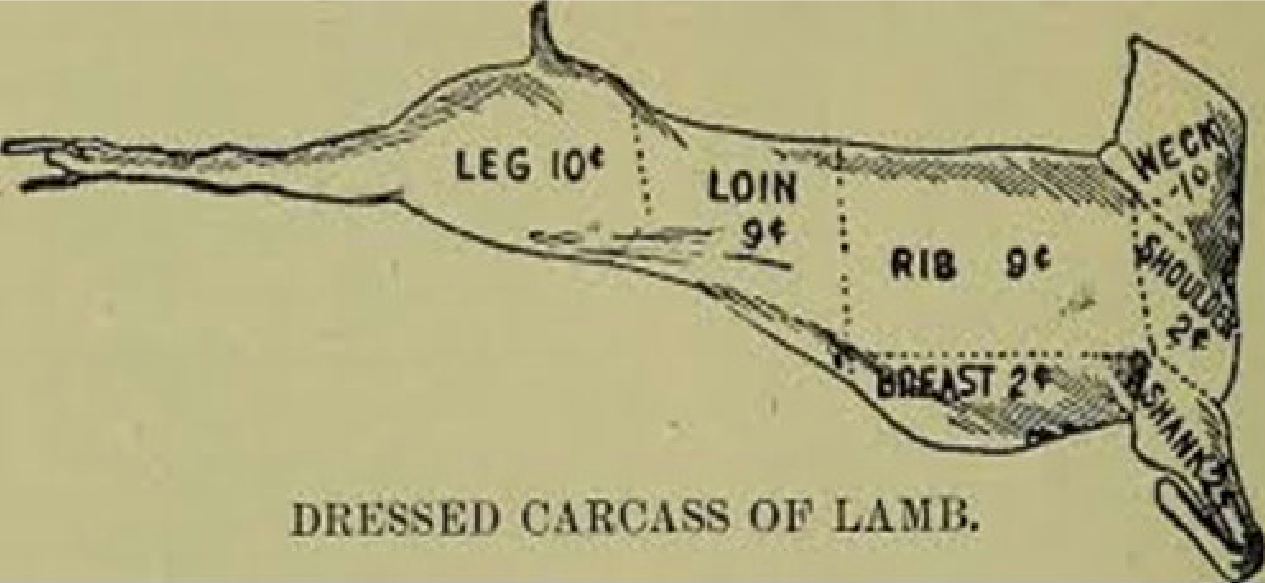
Dressed carcass of lamb- Flickr.com
PRIMAL AND SUBPRIMAL CUTS OF LAMB
After the young sheep is slaughtered, it is usually reduced to the primal cuts: shoulder, breast, rack, loin and leg. Like some veal primals, lamb primals are crosscut sections and contain both bilateral halves (for example, the primal leg contains both hind legs). Lamb primals are not classified into a forequarter and hindquarter like beef, or a foresaddle and hindsaddle like veal.
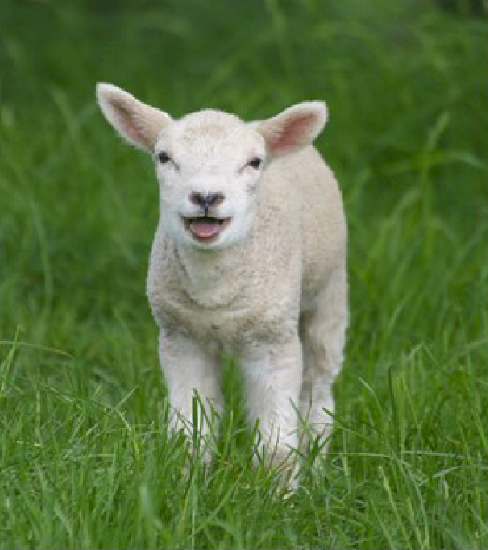
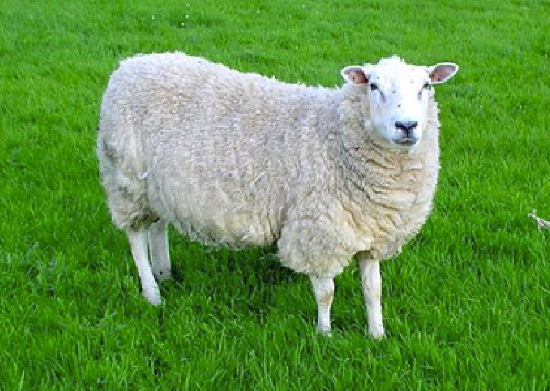
As with all meats, it is important to know the location of bones when cutting or working with lamb. This makes meat fabrication and carving easier and aids in identifying cuts. A lamb carcass generally weighs between 41 and 75 pounds (20 and 35 kg).
SHOULDER
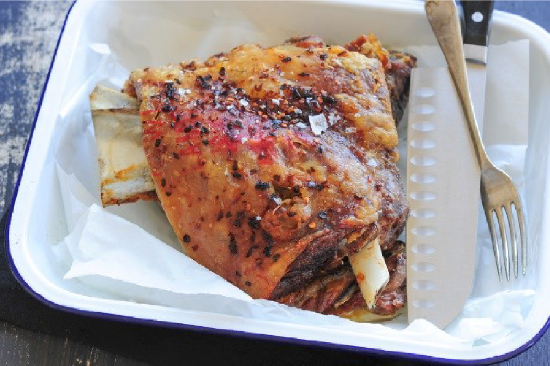
Roasted shoulder of lamb- Flickr.com- notice the shoulder blade on the far left. Lamb and sheep have no articulated joint on their front legs as they do on their back legs. The primal lamb shoulder is a relatively large cut accounting for 36 percent of the carcass weight. The lamb shoulder contains four rib-bones and the arm, blade and neck bones as well as many small, tough muscles whose grains travel in different directions.
All these bones and muscle groups make it nearly impossible to cook and carve a whole shoulder. Although the shoulder may be cut into chops, boned and then roasted, or braised, with or without stuffing, it is more commonly diced for stew or ground for patties.
BREAST
The primal lamb breast contains the breast and foreshank portions of the carcass. Together they account for approximately 17 percent of the carcass weight and contain the rib, breast and shank bones. The primal breast is located beneath the primal rack and contains the rib tips, which are cut off to produce the rack. When separated from the rest of the breast, these small ribs are called ‘Denver ribs’ and can be substituted for pork ribs when desired.
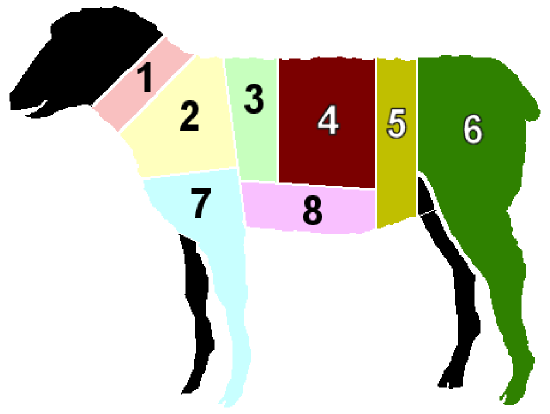
Lamb chart by Wikimedia commons.org - Section 8 is the breast section of the lamb.
Although the breast is not used extensively in food service operations, it can be stuffed and braised, either bone-in or boneless. Lamb foreshanks are quite meaty and may be braised and served as an entree, used for broths or ground.
RACK
The primal lamb rack is also known as the hotel rack. It is located between the primal shoulder and loin. Containing eight ribs and portions of the backbone, it accounts for approximately 8 percent of the carcass weight.
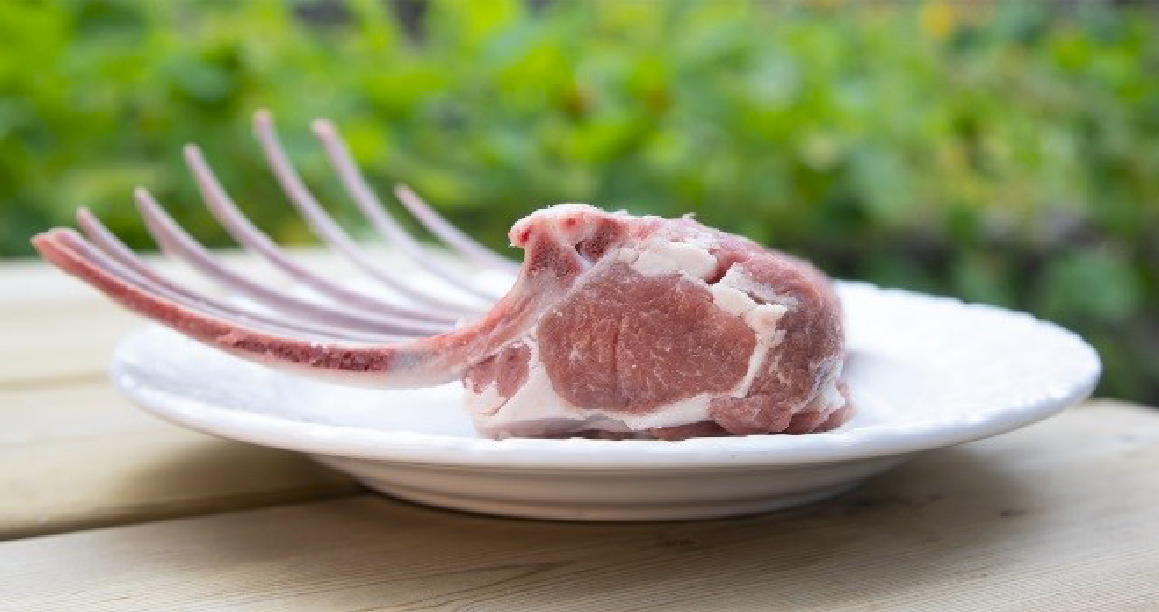
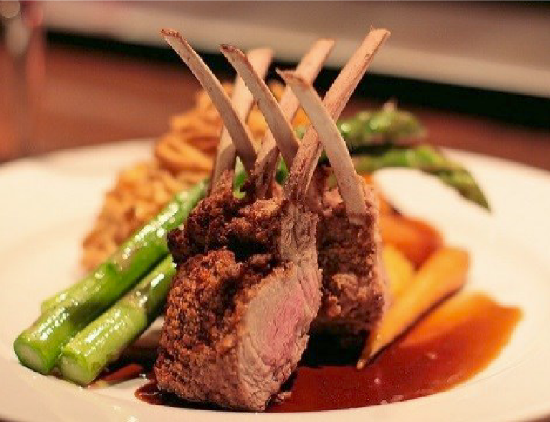
Lamb rack- Wikimedia Roasted rack of lamb - Flickr
The rack is valued for its tender rib eye muscle. The hotel rack is usually split racks can then be grilled , broiled or roasted as racks or cut into single or double rib chops before cooking.
LOIN
The loin is located between the primal rib and leg. It contains rib number 13 and portions of the backbone as well as the loin eye muscle, tender loin and flank. It account s for approximately 13 percent of the carcass weight.
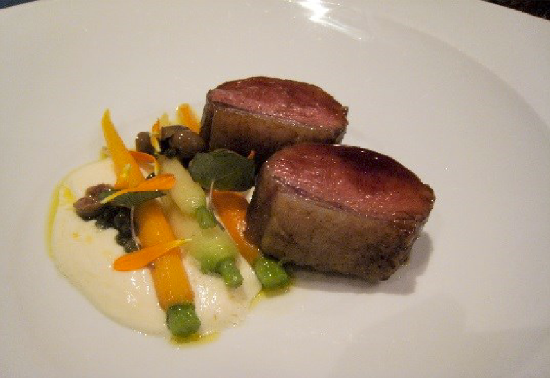
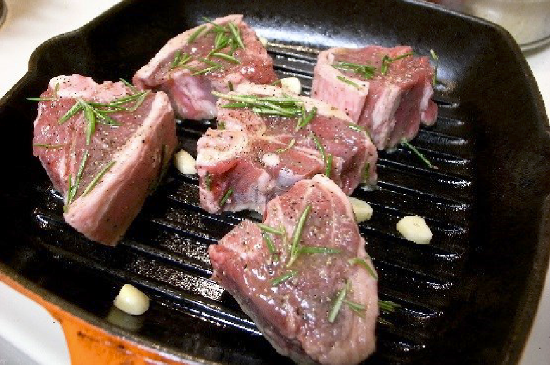
Lamb loin noisette- Wikimedia commons Lamb chops (T-bones) – Wikimedia commons
Except for the flank, the loin meat is very tender and is invariably cooked using a dry-heat method such as broiling, grilling or roasting. The loin may be boned to produce boneless roasts or chops or cut into chops with the bone in. The loin eye may be re moved and cut into medallions or noisette.
LEG
The primal leg is a large section accounting for approximately 34 percent of the carcass weight. It is the posterior portion of the carcass, separated from the loin by a straight cut anterior to the hipbone cartilage. As with veal, the cut of meat that would be the sirloin on a beef carcass is separated from the lamb loin by this cut and becomes part of the primal leg.
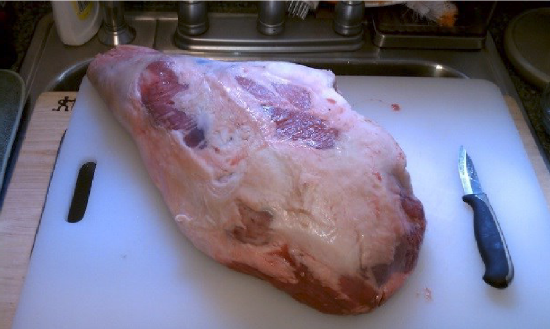
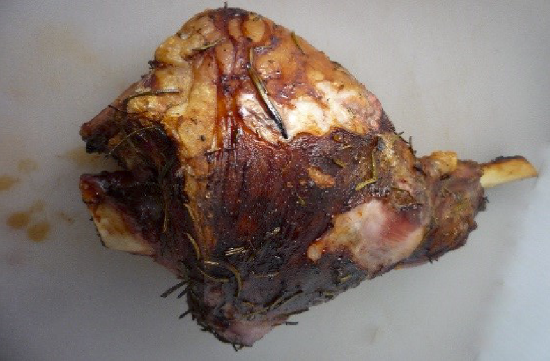
Raw and roasted legs of lamb - Wikimedia commons
The lamb leg contains several bones: the backbone, tail, hip, aitch, round and shank bones. The primal leg is rarely used as is. More often, it is split into two legs, and partially or fully boned. Lamb legs are quite tender - the sirloin end more so than the shank end - and are well suited to a variety of cooking methods. A bone-in leg is often roasted for buffet service or braised with vegetables or beans for a hearty dish. Steaks can also be cut from the bone-in leg, with the sirloin end producing the tenderest cuts. A boneless leg can be tied and roasted, with or without stuffing, or trimmed and cut into scallops. The shank end can be diced for stew or ground for patties.
Because lamb carcasses are so easily handled, purveyors often sell them whole or cut in a variety of ways to better meet their customers' needs. As well as whole-carcass, primal and fabricated cuts, lamb can be purchased in the following forms:
- Foresaddle: The anterior (front) portion of the carcass after it is severed from the hindsaddle by a cut following the natural curvature between the 12th and 13th ribs. It contains the primal shoulder, breast, foreshank, and rack.
- Hindsaddle: The posterior portion of the carcass after it is severed from the foresaddle. It contains the primal loin and leg together with the kidneys.
- Back: The trimmed rack and loin sections in one piece. The back is particularly useful when producing large quantities of lamb chops.
- Bracelet: The primal hotel rack with the connecting breast sections.


